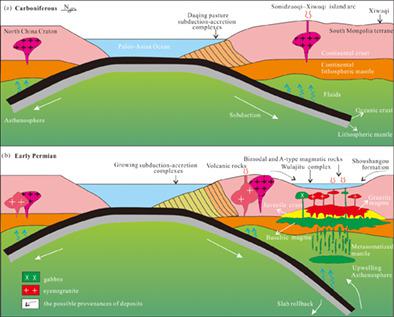当前位置:
X-MOL 学术
›
Geolog. J.
›
论文详情
Our official English website, www.x-mol.net, welcomes your feedback! (Note: you will need to create a separate account there.)
Early Permian back-arc extension in the southeastern Central Asian Orogenic Belt: Evidence from the gabbro–granite complex, Xilinhot, Inner Mongolia, China
Geological Journal ( IF 1.8 ) Pub Date : 2021-04-26 , DOI: 10.1002/gj.4152 Xiaofei Zhang 1, 2, 3, 4 , Zhenshan Pang 1, 3 , Junlai Liu 2 , Xizhu Wei 5 , Shucai Li 4 , Chao Teng 4 , Fuyong Huang 4 , Biren Wang 4
Geological Journal ( IF 1.8 ) Pub Date : 2021-04-26 , DOI: 10.1002/gj.4152 Xiaofei Zhang 1, 2, 3, 4 , Zhenshan Pang 1, 3 , Junlai Liu 2 , Xizhu Wei 5 , Shucai Li 4 , Chao Teng 4 , Fuyong Huang 4 , Biren Wang 4
Affiliation

|
Gabbro–granite complexes provide vital constraints on magmatism mechanisms, crust–mantle interaction processes, and regional tectonics. The petrogenesis and tectonic setting of Early Permian igneous rocks in the southeastern Central Asian Orogenic Belt have long been controversial. In this study, the Early Permian Wulajitu gabbro–granite complex in Xilinhot, Inner Mongolia was selected as a research object and an integrated study was conducted using field occurrence, petrology, zircon U–Pb ages, whole-rock geochemistry, and in situ zircon Hf isotopes. The Wulajitu gabbro–granite complex consists of gabbro and syenogranite with crystallization ages of 277 ± 1 Ma and 274 ± 2 Ma, respectively, belonging to the Early Permian. Their SiO2 contents vary in the range from 43.07–51.60 wt% and 70.30–75.52 wt%, respectively, and exhibit a gap of 51.60–70.30 wt%, displaying a typical bimodal geochemical distribution. The gabbros are low-K tholeiitic–calc-alkaline series rocks that are enriched in large-ion lithophile elements (e.g., Ba, K, and Sr), depleted in high-field-strength elements (e.g., Nb and Ta), and have positive εHf (t) values from +9.3 to +13.2, indicating that they likely originated from partial melting of depleted mantle modified by subduction slab fluids. The syenogranites are aluminous A-type granites characterized by high SiO2 and K2O + Na2O; low Al2O3, CaO, and MgO; depletion in Ba, Nb, Ta, Sr, P, and Ti; enrichment in Rb, Th, U, K, Zr, and Hf; as well as a seagull-type rare-earth element distribution pattern with strongly negative Eu anomalies (Eu/Eu* = 0.30–0.52). They show homogeneous zircon Hf isotopic compositions (positive εHf (t) values from +11.4 to +13.7). All these geochemical signatures suggest that the syenogranites were generated from partial melting of juvenile crust under high temperature and low pressure. The Wulajitu gabbro–granite complex most likely formed in a back-arc spreading basin. Such an extensional regime was closely related to asthenospheric mantle upwelling caused by the rollback of the subducted Palaeo-Asian Ocean slab in the Early Permian.
更新日期:2021-04-26



























 京公网安备 11010802027423号
京公网安备 11010802027423号